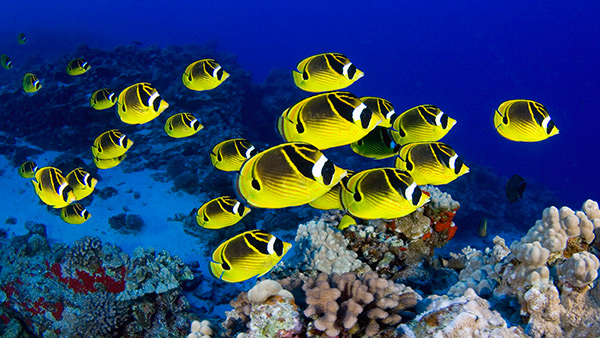Some of the marine fish we like to keep are surprisingly recognizable to both hobbyists and non-hobbyists alike—probably because they’re frequently depicted in photographs and artwork. Among these iconic fishes is the raccoon butterflyfish (Chaetodon lunula) of the Indo-Pacific and southeast Atlantic, a very hardy species that’s better than your average butterfly in terms of aquarium suitability and even beginner-friendliness. C. lunula would also be a great choice for natural pest-anemone control in reef tanks if it could be kept in such a system safely (but, alas, it cannot—more on this later).
Physical traits
C. lunula has “typical” butterflyfish morphology, with a highly laterally compressed body and a pointed snout. Its color is orangish-yellow overall with a dusky hue on the dorsal half of the body and faint diagonal stripes on the ventral half. Like its terrestrial namesake, its eyes are obscured by a black “mask.” Behind the mask is a white bar, and two dark bands edged in yellow extend upward from the white bar. The caudal peduncle features a prominent black “eyespot.” Maximum length for this species is around 8 inches.
Feeding
Fishbase notes that C. lunula adults feed primarily on nudibranchs, tubeworm tentacles, and other benthic invertebrates, as well as algae and coral polyps. Captive specimens will accept a variety of meaty items, such as mysids; chopped clam, shrimp, or fish; and frozen commercial formulas for small carnivores. Multiple small daily feedings are preferable.
Housing
Some sources put minimum housing for this species at 75 gallons, but I would err on the side of a bigger tank—more along the lines of 100 to 125 gallons minimum. Also in keeping with its terrestrial namesake, this species is nocturnal by nature (though it will likely acclimate to daytime activity in time), so be sure to provide a good amount of caves and ledges for it to refuge in/under along with a fair amount of open swimming space to boot (thus my recommendation for a larger tank).
Compatibility
C. lunula is relatively peaceful and will usually get along fine with other live-and-let-live fish species. Multiple conspecifics can be kept together in larger tanks, but they may squabble with one another or with closely related species.
As alluded in my intro above, C. lunula is not a good candidate for reef aquariums. This species will eat or nibble on a wide range of sessile invertebrates, as well as small ornamental crustaceans, and would wreak havoc in such systems.




